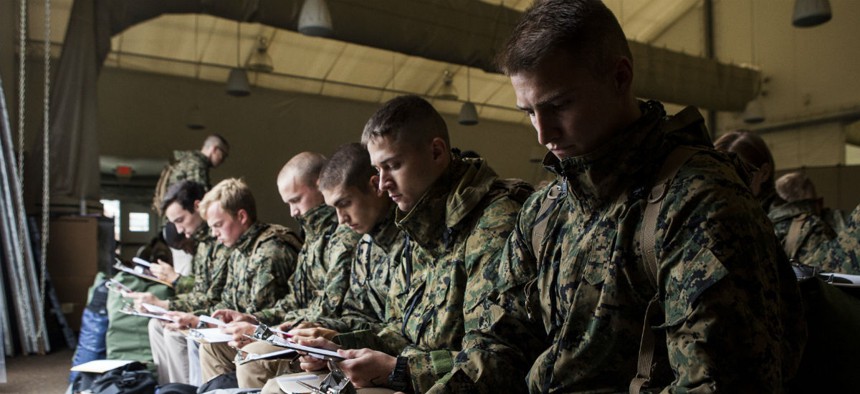Stanford's 'Hacking for Defense' Class Expands to Diplomacy

Jose Villalobosrocha/U.S. Marine Corps
The class unleashed engineering grad students on national security problems.
A Stanford University class that invited engineering students to create products for the Pentagon and the intelligence community will soon do the same for the State Department.
Led by Steve Blank, who pioneered the lean startup methodology, the Hacking for Defense class completed its first run this spring; Hacking for Diplomacy starts in the fall. The courses ask government officials for specific challenge ideas—in Hacking for Defense, some worked on a communication app, others on a wearable device that can monitor a diver's physiological traits and students applied in teams to work on individual projects.
One of Blank's goals was to show tech-minded students their skills could solve problems facing the government, just as they might in the consumer or business worlds, he told Nextgov. The class might "provide another venue" for civic-minded students to help the government, in addition to joining new and much-hyped federal groups such as 18F or the U.S. Digital Service.
» Get the best federal technology news and ideas delivered right to your inbox. Sign up here.
The first iteration of Hacking for Defense has been successful by a few metrics, Blank and his team of professors say. Two student teams will continue their projects even though class has ended. Other universities, including the University of California at San Diego, have signed up to teach their own versions.
The State Department will participate in Hacking for Diplomacy, with challenges including anticipating the spread of mosquito-borne disease. The U.S. Special Operations Command also has funded two teams who plan to continue building prototypes over the summer, and one team closed a $200,000 early stage funding round during class.
But there were also a handful of challenges—government advisers weren't always sure of their role in student teams, among others—so Blank and his team are introducing new training for government participants in the next version of the class.
The final products were less important than internalizing principles of the lean startup model, Pete Newell, a retired colonel who previously directed the Army’s Rapid Equipping Force and a Hacking For Defense professor, told Nextgov. The model teaches students to talk to all stakeholders, incorporating feedback into designs and eventually, minimum viable prototypes.
Interviewing government representatives, including acquisition leaders, contracting officers and end users—a process known as "customer discovery"—was also a critical lesson for students.
In one case, a student team probed government employees about what they initially thought was a technical challenge facing the agency, but turned out to be an organizational silo in which government groups weren't communicating with each other, Blank said.
Professors selected challenges that could serve both the commercial and public sectors to entice tech-minded students who might have pursued private-sector jobs. However, forming new companies to sell those products wasn't the purpose of the course, Newell told Nextgov.
Though one team raised its own funding, advisers were told not to discuss money with student teams; if funding is introduced too early, a team might settle on a design instead of continuing the customer discovery and prototyping process, Newell explained.
And some students needed more guidance about how much time to spend on product development and customer discovery, Blank said.
"Smart technical students tend to want to build the technology first and build a great demo," he said. "The DOD has more demos than they'll ever need in their lives ... the point of class was to build something that would get deployed."
Still, the class has helped students and government participants communicate using terms such as "lean methodology," said Joe Felter, another retired colonel who helped teach Hacking for Defense and will participate in Hacking for Diplomacy.
"By the end of the course, the student teams and the [government] sponsors are speaking basically the same language," he said. "They've closed a lot of the cultural gaps."
NEXT STORY: USAID crowdsources 21 ideas for fighting Zika





